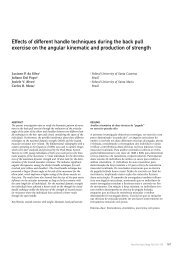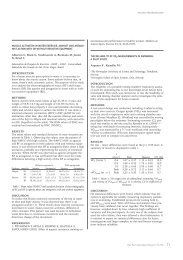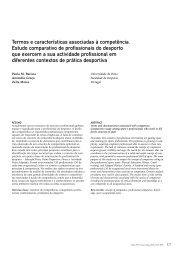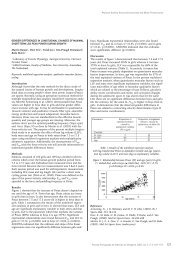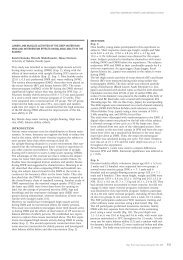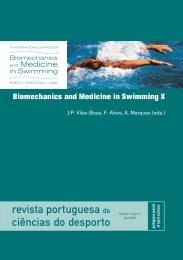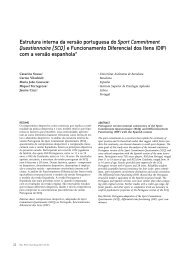download PDF - Faculdade de Desporto da Universidade do Porto
download PDF - Faculdade de Desporto da Universidade do Porto
download PDF - Faculdade de Desporto da Universidade do Porto
Create successful ePaper yourself
Turn your PDF publications into a flip-book with our unique Google optimized e-Paper software.
160<br />
Exercício contínuo e intermitente: Efeitos <strong>do</strong> treinamento<br />
e <strong>do</strong> <strong>de</strong>streinamento sobre o peso corporal e o metabolismo<br />
muscular <strong>de</strong> ratos obesos<br />
Larissa Braga<br />
Maria Mello<br />
Fúlvia Mancha<strong>do</strong><br />
Claudio Gobatto<br />
RESUMO<br />
Este estu<strong>do</strong> teve como objetivo comparar os efeitos <strong>de</strong> programas<br />
<strong>de</strong> treinamento contínuo e intermitente e <strong>do</strong> <strong>de</strong>streinamento<br />
sobre a adiposi<strong>da</strong><strong>de</strong> corporal e o metabolismo muscular<br />
<strong>de</strong> ratos obesos. Foram utiliza<strong>do</strong>s ratos Wistar, recém-nasci<strong>do</strong>s,<br />
que receberam glutamato monossódio (MSG), via subcutânea,<br />
4mg/g peso corporal (p.c.), a ca<strong>da</strong> <strong>do</strong>is dias, nos primeiros 14<br />
dias <strong>de</strong> vi<strong>da</strong>. Após o <strong>de</strong>smame, foram separa<strong>do</strong>s em 3 grupos:<br />
MSG-SED (se<strong>de</strong>ntário), MSG-CONT (treino contínuo = natação,<br />
45 min/dia, 5 dias/semana, com sobrecarga <strong>de</strong> 5% p.c.<br />
durante 10 semanas) e MSG-INT (treino intermitente = natação,<br />
15 seg <strong>de</strong> ativi<strong>da</strong><strong>de</strong>/15 seg <strong>de</strong> repouso, num total <strong>de</strong><br />
45min, 5 dias/semana, com sobrecarga <strong>de</strong> 15% <strong>do</strong> peso corporal).<br />
Como controles foram utiliza<strong>do</strong>s ratos que receberam<br />
solução salina (SAL) separa<strong>do</strong>s em 3 grupos: SAL-SED, SAL-<br />
CONT e SAL-INT. Os animais foram avalia<strong>do</strong>s após 12 semanas<br />
<strong>de</strong> treinamento e 8 semanas <strong>de</strong>pois <strong>de</strong> sua interrupção. Os<br />
ratos MSG mostraram maiores teores <strong>de</strong> gordura na carcaça<br />
que os SAL, comprovan<strong>do</strong> a eficácia <strong>da</strong> droga em causar obesi<strong>da</strong><strong>de</strong>.<br />
Ambos os protocolos <strong>de</strong> treino foram eficazes em reduzir<br />
significativamente o ganho <strong>de</strong> peso <strong>do</strong>s ratos SAL e MSG bem<br />
como a produção muscular <strong>de</strong> lactato <strong>do</strong>s ratos MSG. Os efeitos<br />
<strong>do</strong>s <strong>do</strong>is protocolos foram transitórios, uma vez que após o<br />
<strong>de</strong>streinamento os benefícios observa<strong>do</strong>s foram reverti<strong>do</strong>s.<br />
Palavras-chave: obesi<strong>da</strong><strong>de</strong>, treinamento intermitente, treinamento<br />
contínuo, glutamato monossódico, rato.<br />
Rev Port Cien Desp 6(2) 160–169<br />
Universi<strong>da</strong><strong>de</strong> Estadual Paulista<br />
Instituto <strong>de</strong> Biociências<br />
Departamento <strong>de</strong> Educação Física<br />
Rio Claro<br />
São Paulo<br />
Brasil<br />
ABSTRACT<br />
Continuous and intermittent exercise: Effects of training and<br />
<strong>de</strong>training on body weight and muscle metabolism in obese rats<br />
This study was <strong>de</strong>signed to compare the effects of continuous and intermittent<br />
exercise training on body weight, carcass composition and muscle<br />
metabolism in obese rats. Obese male Wistar rats (treated with<br />
monosodium glutamate-MSG-administration, 4mg/g body weight,<br />
administered every 2 <strong>da</strong>y, from birth to 14 <strong>da</strong>ys of age) were used.<br />
After drug administration, the rats were separated into three groups:<br />
MSG-SED (se<strong>de</strong>ntary), MSG-CONT (continuous training = swimming,<br />
45 min/<strong>da</strong>y, 5 <strong>da</strong>ys/week, with an overload of 5% body weight<br />
during 12 weeks) and MSG-INT (intermittent training = 15 sec<br />
swimming intermitted by 15 sec rest, during 45min, 5 <strong>da</strong>ys/week, with<br />
an overload of 15% body weight during 12 weeks). Rats of the same<br />
age and strain, administered with saline (SAL) were used as controls<br />
and subdivi<strong>de</strong>d into three groups: SALT-SED, SALT-CONT and SALT-<br />
INT. The animals were evaluated after 12 weeks of training and after<br />
8 weeks of <strong>de</strong>training. MSG rats showed higher carcass fat content<br />
than SAL rats, indicting the effectiveness of the drug in causing obesity.<br />
Both training protocols were effective in reducing significantly body<br />
weight gain of SAL and MSG rats as well as the lactate production by<br />
the skeletal muscle of the MSG rats. The effects of the two protocols<br />
were transitory, since after the <strong>de</strong>training period the observed benefits<br />
were reverted.<br />
Key Words: obesity, intermittent training, continuous training,<br />
monosodium glutamate, rat.



